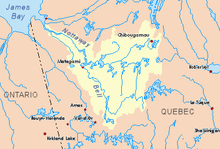|
Mistago River
The Mistago River is a tributary of the Barlow River (Chibougamau River), flowing into the Regional County Municipality (MRC) of Eeyou Istchee Baie-James, in Jamésie, in the administrative region of Nord-du-Québec, in the province of Quebec, at Canada. The course of the river flows into Plamondon Township, Richardson Township and Blaiklock Township. This river flows into the Mistissini (Cree village municipality), into the Albanel Lakes Wildlife Reserve, Mistassini and Mistago and into the Assinica Wildlife Sanctuary. The hydrographic slope of the Mistago River is accessible by a forest road (North–south direction) which cuts the river and connects to route 167 south-west of Waconichi Lake; the latter road comes from Chibougamau, going north-east along the southeast shore of Waconichi Lake and the river of the same name. The surface of the "Mistago River" is usually frozen from early November to mid-May, however traffic Ice safety is usually from mid-November to mid-April. GeographyThe main hydrographic slopes near the "Mistago River" are:
The "Mistago River" originates at the mouth of an unidentified lake (length: 0.4 kilometres (0.25 mi); 419 metres (1,375 ft)) in the Mistissini (Cree village municipality). This source is located at:
The Mistago River flows on the North shore of the Barlow River (Chibougamau River). The latter flows towards the Southwest and flows into a river bend on the north shore of the Chibougamau River in a marsh area upstream of Chevrillon Lake. From there, the current flows towards the South-West by borrowing the Chibougamau River, until its confluence with the Opawica River. From this confluence, the current flows generally to the southwest by the Waswanipi River to the east shore of Goéland Lake (Waswanipi River). The latter is crossed to the northwest by the Waswanipi River which is a tributary of Matagami Lake. The mouth of the "Mistago River" located at:
ToponymyOf Cree origin, this hydronym means "the White River". The toponym "Mistago River" was formalized on December 5, 1968, at the Commission de toponymie du Québec, that is to say, the foundation of this commission.[2] References
See also
|
||||||||||||||||||||||||||||||||
Portal di Ensiklopedia Dunia
